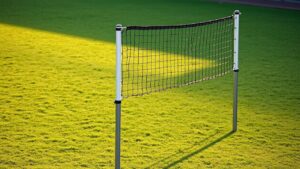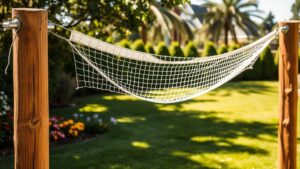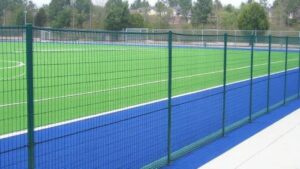In the world of baseball and softball, training and practice are key to improving performance and developing skills. Whether you’re perfecting your batting, practicing your pitching, or working on fielding techniques, having the right equipment makes a world of difference. One such essential tool is a high-quality net. Baseball and softball nets come in various types designed for specific purposes, such as pitching, hitting, and throwing.
These nets play a crucial role in enhancing skill development, improving safety, and providing an efficient way for coaches and players to focus on their techniques. In this guide, we will explore the different types of baseball and softball nets available, their benefits, and how to choose the right net for your training needs. Additionally, we’ll discuss the importance of using these nets in both indoor and outdoor settings, maintenance tips, and how they contribute to more effective and safe practice sessions.
What Are the Different Types of Baseball and Softball Nets?
Baseball and softball nets are specialized equipment designed to serve different functions during training. These nets range from those used for pitching practice to those designed for hitting and fielding drills. One of the most common types is the hitting net. A hitting net for baseball or softball is designed to catch the balls during batting practice, ensuring that the hitter can focus on perfecting their swing without worrying about chasing balls around the field.
One more type of net is the pitchback net, which bounces the ball back to the user, allowing for continuous pitching or throwing drills. Pitching nets with strike zone targets are also highly useful for helping pitchers aim and improve their accuracy by providing a visual cue of where to aim their pitches.

What is a Softball Net for Pitching?
A softball net is specifically designed for pitchers who need to practice their pitching mechanics. These nets are equipped with a target area that simulates the strike zone, allowing pitchers to aim their pitches with greater accuracy. Many softball pitchers use pitching practice nets as a way to develop better control over their throws and refine their pitching speed. The benefits of a pitching screen net are not only focused on accuracy but also on the safety of both pitchers and coaches during practice sessions.
By using a baseball and softball nets with a strike zone target, pitchers can receive immediate feedback on their accuracy and consistency. This is especially beneficial in improving pitching mechanics and ensuring that pitches stay in the strike zone. For coaches, a softball pitching net offers the convenience of being able to observe and provide feedback without having to retrieve the balls after each pitch.
How Do Softball Nets for Hitting Enhance Performance?
A softball hitting net plays a crucial role in helping batters improve their performance during practice. Whether you’re practicing at the local field or in a batting cage, having a net that can catch balls effectively is essential for a smooth and continuous practice session. Hitting nets are specifically designed to withstand the impact of fast-moving balls, which makes them highly durable and long-lasting.
Another key advantage of using a hitting net with a strike zone is that it provides a consistent target for the batter. By focusing on hitting the balls into the net’s center, batters can enhance their accuracy and control. This is crucial for improving contact and timing when facing real pitchers in games.
How to Choose the Right Baseball and Softball Nets for Training?
Selecting the right baseball and softball nets is essential for effective training. When choosing a net, you need to consider factors like durability, size, and the specific type of practice you intend to use it for. A batting net should be durable enough to withstand high-impact balls from batting practice, while a pitching screen needs to be sturdy enough to protect players from errant throws. Additionally, you’ll want to make sure the net is easy to set up and store, especially if you’re limited on space or need a portable solution.
When choosing a baseball and softball nets, it’s important to evaluate the size of the net, the material it’s made from, and its ease of setup. Nets with steel frames are often more durable and weather-resistant than those made from lighter materials. A net with a bow frame can offer additional stability, especially in windy conditions. Furthermore, choosing nets that come with carry bags or compact storage solutions can make it easier to transport and store your equipment.
How Do You Determine the Best Softball Hitting Net for Your Needs?
Choosing the right baseball net is crucial for maximizing the effectiveness of your batting practice. The best hitting net for softball will depend on a few key factors: the type of practice you’ll be doing, the space available, and the durability of the net. If you plan on practicing with softballs or baseballs of varying sizes, a softball hitting net with ample depth and width is important to catch the balls securely.
For effective practice, look for nets that provide a strike zone target or nets that offer a reliable rebound system. A pitchback net allows the ball to return to the batter after hitting the net, which can enhance your practice efficiency by keeping the session continuous.
It’s also essential to consider the material and frame of the net. A portable batting net is convenient for quick setups, but it should still be strong enough to withstand repeated impacts. Nets made from high-quality materials, such as nylon or polyester, are more durable and long-lasting than cheaper alternatives.
What Features Should You Look for in Softball Training Nets?
When selecting a softball training net, there are several features to look for to ensure that the net meets your training needs. First and foremost, durability is key. Training nets should be able to withstand the constant use during batting, pitching, or throwing drills. Opt for nets with reinforced edges and steel frames for added strength and longevity.
For hitting drills, look for hitting nets that offer stability, allowing players to hit balls without worrying about the net moving or falling. A hitting net with a pocket can help with the ball retrieval process, reducing the need for constant ball retrieval during practice.
Where Can You Use Baseball and Softball Nets Effectively?
Baseball and softball nets can be used effectively in a variety of settings, including both indoor and outdoor environments. These nets provide flexibility, allowing players to practice anywhere, whether they are at a local field, a batting cage, or even in the comfort of their own backyard.
For indoor practice, nets like the portable batting net and pitching practice net are ideal. These nets can be easily set up in a gym or a large indoor space, allowing players to hone their skills year-round, even when the weather is unfavorable. Whether you’re working on hitting drills or pitching practice, indoor nets can simulate the experience of being on the field without the need for expansive outdoor space.
Outdoors, baseball and softball nets can be used in a variety of conditions. Pitching screens and hitting nets can withstand the elements, making them perfect for training in all seasons. Whether you’re practicing your fastball with a pitching screen or hitting balls into a hitting net, outdoor nets can be set up in your backyard, at local fields, or at baseball net for batting facilities. A 7×7 hitting net can be ideal for baseball or softball players who need a large net to catch the balls after hitting them with high velocity.

Is It Possible to Use a Softball Net in Small Spaces?
Yes, it’s entirely possible to use a softball net in small spaces. For players who may not have access to a large outdoor field or training facility, smaller nets offer a practical solution. Compact options like batting tees and pitchback nets allow players to practice in tight areas, such as a garage, basement, or even a small backyard. These smaller nets are designed to catch balls reliably without requiring a large area to set up, making them ideal for softball and baseball practice net in confined spaces.
Additionally, some pitching practice nets and hitting nets come in foldable or collapsible designs, making them easy to store in small spaces when not in use. These nets are lightweight and portable, allowing players to quickly set them up and pack them away after practice. A net with a cutout or a pocket net can also be a great space-saving option, as it provides a specific target area for drills without taking up much room.
Can Softball Nets Be Used Outdoors and Indoors Effectively?
Softball nets are designed to be highly versatile, allowing for effective use both outdoors and indoors. Outdoors, softball nets are built to withstand different weather conditions, including wind, rain, and sun exposure. A screen pitching net can be placed on the field to protect players while they practice pitching mechanics or throwing drills.
For indoor use, portable nets like the baseball and softball nets are perfect for creating a structured practice environment. These nets can be set up in gyms, basements, or other indoor spaces, providing players with a reliable target for batting practice or pitching drills. The net for hitting or throwing can be easily adjusted to fit within the available space, ensuring that players have the ability to practice their skills no matter the setting.
How to Maintain and Care for Your Softball Nets?
Maintaining and caring for your pitching target baseball net is essential to ensure that it lasts through numerous training sessions. First, after each practice, it’s important to remove any dirt or debris from the netting. Use a brush or cloth to gently wipe the net clean. If the net gets wet, allow it to dry completely before storing it, as moisture can cause mold or mildew buildup over time.
For baseball and softball nets that are used frequently, a more thorough cleaning may be necessary. You can wash the net using a mild soap solution and a soft brush. Avoid using harsh chemicals that could damage the fibers of the net.
What Are the Best Practices for Cleaning Your Softball Net?
Cleaning your softball training net is essential for maintaining its durability and performance. After each practice, brush off any dirt, dust, or grass that may have accumulated on the net. If the net is particularly dirty, use warm water and a mild detergent to clean it. Be sure to avoid using bleach or harsh chemicals, as these can break down the fibers and reduce the net’s lifespan.
For pop up baseball pitching net, which may collect dirt from the field, it’s also recommended to wash them regularly to maintain their structure. Hang the net to dry completely, as moisture can weaken the material over time. Additionally, if your net is exposed to extreme weather conditions, consider storing it in a dry, cool place when not in use, or using a protective cover to shield it from the elements.
How Can Improper Setup of a Softball Net Affect Training?
Improper setup of a softball net can significantly hinder training progress. If a batting net or pitching practice net is not positioned correctly, players may not be able to work on their techniques efficiently. For instance, a pitching net that is too close to the pitcher may not offer enough space to practice the full range of throwing mechanics. Alternatively, a batting net that is not properly aligned may cause players to miss their target, which can be frustrating and counterproductive during training.
Nets that are not set up correctly can also pose safety risks. A pitching screen or batting net that is not anchored properly may fall over or move during use, increasing the risk of injury to players. It’s important to make sure the net is stable and positioned correctly to maximize safety and effectiveness during practice sessions.
What Should You Know About Softball Hitting Net Options?
When choosing a baseball and softball nets, you should consider the features that will best support your training needs. A net for hitting should be sturdy enough to withstand the impact of hard-hit balls, and it should be large enough to catch balls of different sizes. Softball hitting nets often come in various sizes, so consider the available space and your specific training requirements.
If you plan to practice in a smaller area, look for a batting net with a compact design. Some nets even feature strike zone targets that can help you work on accuracy and precision. Additionally, a net combo, which includes both a batting tee and a net, is a great choice for those looking to get both hitting and pitching practice in one convenient setup.
What Are Some Recommended Brands for Baseball and Softball Nets?

Several brands are well-known for producing high-quality softball and baseball practice nets. Some of the most reputable brands include:
- Tanner – Known for their Tanner batting net, which is durable and highly rated by both professional athletes and recreational players.
- SKLZ – Offers a variety of baseball and softball nets, including pitchback nets and batting practice nets, that are well-regarded for their portability and ease of setup.
- Bownet – Popular for their net with bow frame design, Bownet nets are easy to assemble and highly durable, making them a great choice for both softball pitchers and batters.
Which Brands Are Known for High-Quality Softball Pitching Nets?
For high-quality softball pitching net, consider brands like SKLZ and Bownet, both of which produce nets specifically designed to handle the demands of pitching practice. Bownet’s pitching nets are designed with stability in mind, while SKLZ nets are often praised for their durability and versatility. These nets are excellent for players who want to improve their pitching mechanics or accuracy in the strike zone.
Conclusion
In conclusion, investing in the right baseball and softball nets is essential for any player looking to improve their skills. Whether you’re working on baseball pitching mechanics or refining your swing with a baseball net for batting, having high-quality gear ensures that every practice session is effective.
Investing in the right baseball and softball nets is crucial for effective practice. Whether you’re looking for a pitching practice net, batting net, or softball hitting practice net, there are plenty of options available to suit every player’s needs. Ensuring the proper setup, maintenance, and use of your nets will maximize their effectiveness and extend their lifespan. With the right equipment and consistent practice, you can improve your skills and get one step closer to your training goals.
FAQs
Can I use a softball net for baseball practice?
Yes, many nets are versatile enough to be used for both softball and baseball practice, but ensure that the net is suitable for the specific activity you’re practicing, whether it’s pitching or hitting.
What’s the best net for pitching practice?
A pitching practice net with a strike zone target is ideal for improving accuracy. Look for pitching nets that are sturdy and can withstand high-speed pitches.
Are portable hitting nets effective?
Yes, portable hitting nets like the 7×7 hitting net are highly effective, especially for batting practice in smaller spaces or while traveling.
How do I maintain my baseball or softball net?
Regular cleaning and inspection for wear and tear are essential. Dry the net thoroughly before storing it, and check for any damage after each use to ensure its longevity.
Can I set up a softball net in a small space?
Yes, smaller nets, such as pitchback nets and batting tees, are perfect for tight spaces, allowing you to practice your skills in smaller areas like a garage or backyard.











